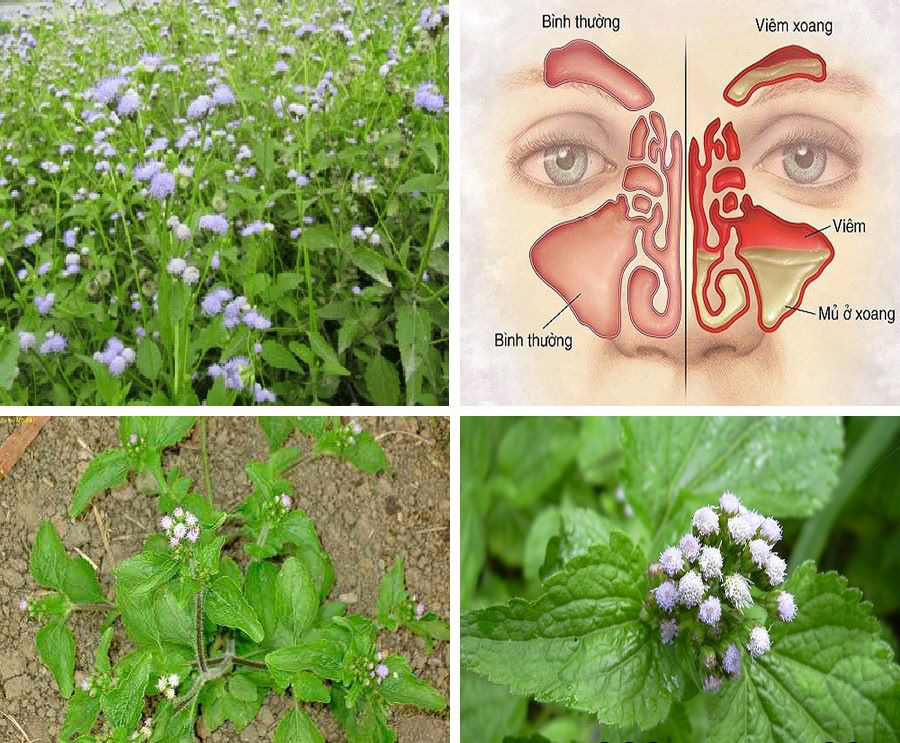Stinking Grass, scientifically known as Ageratum conyzoides. It is commonly referred to as pig dung or five-color grass and is widely used in traditional medicine for its anti-inflammatory, antibacterial, and antifungal properties. The plant is utilized to treat various conditions such as sinusitis, skin diseases, joint pain, and digestive disorders. However, it must be used correctly to avoid potential toxicity.
The chemical components of stinking grass (pig dung), scientifically known as Ageratum conyzoides, play a vital role in the preparation of medicinal herbs and are used to treat numerous ailments. However, this medicinal herb can accumulate toxins, making proper usage knowledge essential for safety.

 Stinking grass (pig dung) has the effect of curing many diseases – Illustration photo
Stinking grass (pig dung) has the effect of curing many diseases – Illustration photo
Medicinal Properties and Chemical Composition
According to Dr. Quach Tuan Vinh, a member of the Executive Committee of the Hanoi Oriental Medicine Association, stinking grass (also known as five-color) grows wild in many regions. It’s widely used in folk medicine for its anti-inflammatory, pain-relieving, antibacterial, and antifungal properties.
Modern research has identified several important chemical components in stinking grass that contribute to its medicinal properties:
- Essential oils
- Saponin
- Caryophllene
- Ancoloid
- Demethoxygeratocromen
- Cadinne
- Fumaric acid
- Phenol
- Quercetin
- Coumarins
- Resins
- Tanins
- Kaempferol
- Charomones
- Caffeic acid
Traditional and Modern Medicinal Uses
In traditional medicine, stinking grass is characterized as cool, spicy, and slightly bitter. It has cooling, detoxifying, anti-hemorrhagic, and anti-inflammatory properties.
Treating Sinusitis and Allergic Rhinitis
Stinking grass is commonly used in folk medicine to treat upper respiratory tract infections. Its anti-inflammatory and anti-allergic compounds help reduce swelling, pain, and clear nasal passages.
Usage methods:
- Fresh juice application: Wash leaves, crush them, and squeeze out the juice. Apply 1-2 drops into each nostril to relieve nasal congestion and sinus pain.
- Nasal steaming: Boil fresh plants with water and use the steam in the nasal area to clear congestion, reduce swelling, and expel mucus.
 Folklore often uses the stinking grass plant to treat sinusitis – Illustration photo
Folklore often uses the stinking grass plant to treat sinusitis – Illustration photo
Treatment of Skin Diseases
Stinking grass demonstrates effective antibacterial and antifungal properties, particularly for skin diseases caused by bacterial or fungal infections such as dermatitis, nail fungus, and foot fungus. Studies show its extracts can resist pathogenic bacteria and fungi, especially Staphylococcus aureus and Candida albicans.
Usage methods:
- External application: Wash leaves, crush them and apply to infected areas. Maintain for 15-20 minutes, then rinse with clean water. Apply 2-3 times daily until symptoms improve.
- Supportive drink: Combine external treatment with a low-dose decoction to increase effectiveness and prevent reinfection.
Pain Relief and Anti-inflammatory Benefits
The plant contains compounds that provide pain-relieving and anti-inflammatory effects, beneficial for treating arthritis and muscle pain. These compounds inhibit inflammatory enzymes, reducing swelling and pain. Research in Brazil has shown its effectiveness in reducing pain and inflammation in animal models of arthritis.
Usage methods:
- Oral consumption: Use 10-15g of dried plant, boil with water, and drink 1-2 times daily to reduce pain and inflammation in joint diseases and muscle pain.
- External application: Crush fresh leaves and apply to inflamed joints or painful muscles.
Digestive Disease Support
Stinking grass helps treat digestive ailments including bloating, indigestion, and intestinal infections.
Usage method:
- Decoction: Use 10g of dried plant or 20g of fresh plant, prepare a decoction, and consume 2-3 times daily to reduce digestive disorder symptoms.
Chronic Disease Prevention
The flavonoids and polyphenols in stinking grass provide strong antioxidant properties that protect cells from free radical damage, potentially reducing the risk of chronic diseases like cancer, diabetes, and cardiovascular disease.
Usage method:
- Drink a decoction to increase antioxidant capacity and protect overall health.
Other Traditional Applications
- Otitis media: Crush the herb, extract juice, and apply 1-2 drops into the ear 4 times daily.
- Rheumatism and sprains: Combine fresh stinking grass with rice and salt, roast, and grind finely. Apply to swollen joints for 1-2 hours, 2-3 times daily.
- Sore throat: Crush leaves, extract juice, add sugar, and consume 3 times daily.
- Hair care: Apply crushed fresh leaves to hair, cover for 2-3 hours, then wash. Regular use promotes fragrant, smooth, dandruff-free hair.
- Fever reduction: Drink a decoction of boiled grass roots 2-3 times daily.
Safety Considerations
Dr. Quach Tuan Vinh emphasizes that despite its many medicinal uses, proper usage is essential:
- Short-term use only: Stinking grass can accumulate toxic substances with prolonged use. Limit usage to 1-2 weeks until symptoms subside.
- Contraindicated for pregnant and lactating women: Due to insufficient safety research, pregnant and breastfeeding women should avoid this herb.
- Caution with children: Children, especially those under 5, have sensitive bodies. Consult a specialist before administering the herb to children.
- Potential drug interactions: Exercise caution when combining with Western medicine, particularly anti-inflammatory drugs and pain relievers, as interactions may affect medicine efficacy.
- Allergic reactions: Some individuals may experience allergic reactions including itching, rash, or breathing difficulties. Discontinue use immediately and seek medical attention if allergic symptoms occur.